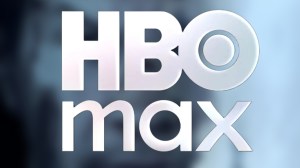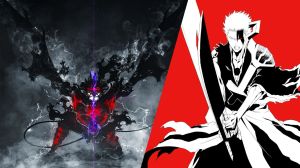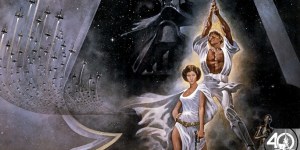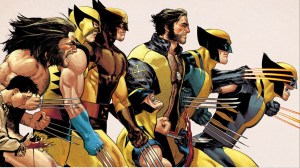Last week, Boom! Studios released the first-ever officially-licensed visual adaptation of Rod Serling’s original screenplay for Planet of the Apes.
Videos by ComicBook.com
The screenplay, which has the same basic structure as the classic 1968 film but differs in some significant respects, was adapted for comics by Stan Against Evil showrunner Dana Gould and artist Chad Lewis, under the editorial eye of Boom!’s Dafna Pleban, who recruited Gould and helped him write his first comics script.
Gould, Lewis, and editor Dafna Pleban joined ComicBook.com for a roundtable discussion of the project, which is available now in hardcover.
To start at the end — looking through the back matter, and having you specifically call out actors and influences who you visualize these people as, but obviously there’s likeness rights issues.
So is it a difficult balancing act to take imagery and say, “Well, I really want to evoke such-and-such, but I don’t want to evoke it so much that we can get in trouble?”
Chad Lewis: In theory, yes. I think if I was drawing Paul Newman, and you knew immediately that was Paul Newman, that it would be an issue. The reality of it is if I have something I’m looking at as inspiration, usually I’m sketching emotions, things like that, of characters. The reality is that there’s a general likeness, there’s some inspiration, but my hand does what my hand does. In a perfect world it would be an issue because I’d be drawing photorealistically, but the reality is, it goes through a creative filter for most everything.
Dafna Pleban: I think you’re selling yourself a little short, Chad. There are actors who serve as inspiration but within the context of the needs of the script. The elements that remind us of them without necessarily being a complete copy or one-to-one. So you think Paul Newman instead of Charlton Heston, and then in the book itself, Paul is somewhere in the middle and very much becomes Thomas.
Lewis: Yeah, and I think we were lucky because having Serling as an inspiration freed me up to make it my own, but it’s inspired by all these things. But we’re looking at all these actors, and we’re looking at past and present, but in the end, the idea was to have as much creative freedom as possible, and you can see that Boom! and Fox were really amazing about allowing this book to take shape on its own.
Dafna, you helped this book take its current shape, Dana says in the afterward, because it was a learning process, him getting to do comics versus screenplays and doing it on such a big stage with a long book. What was that creative process like?
He is being a little bit modest there. At times, we had to learn on the fly, but on the whole, his script came through incredibly well. Before Chad was on the book, I could talk to Dana about this book. We had the idea for a few years, kicking around internally, and we really wanted to make it something as special as we understood it could be. Serling is one of his favorite writers, but also with you get to tell a Planet of the Apes story that’s a version of the classic film that you know so well.
What’s so great about working with Dana is, we kind of tackled the script in chunks, so we could really hone in on what would make it a comic. We initially made a lot of cuts, because there’s a lot of dialogue in the screenplay that did not make it into the book because, in a comic, a lot of dialogue actually doesn’t make sense. It makes it difficult to read and actually gets in the way.
Dana Gould: Rod Serling really is one of my heroes, my top three or four. I’m actually right by my desk. In my office, I have an old interwoven sock ad that he did in a frame. Picture of him sitting at a desk, bare feet. It says, “While Rod Serling is writing stories and curling her hair, he wears socks that turn your head.”

So he was a big hero of mine, and the idea of having to make editorial decisions on his work was daunting, to put it mildly, and I really did sweat every change I made, but the format dictated it. There’s no way around it. You read over these things and read over these things to really try to boil down to just the raw kernel of what he was really trying to put forth, and then you go from there. I hope if there’s an afterlife, he’s kind.
Often, when writers come from film, their comics tend to be somewhat static in their layout. This book did not have that. This book very much felt like a Boom! Planet of the Apes comic, with pages that were really dynamic in a way that not everybody coming from a screenwriting background manages to capture. Was that something that you guys were conscious of?
Gould: A lot of that is Chad. I grew up reading comic books, so although I had to learn the writing format, I was very familiar with the storytelling job of a graphic novel. The great thing about Planet of the Apes is that it’s social satire, but it’s also an action/adventure story. It’s exciting and it’s fun to watch. There’s a reason that I got into at 10 years old, not even knowing why I liked it.
That was always weighing on my mind. I wanted to keep it interesting and exciting, and keep the train moving. Oddly, my favorite graphic novel is probably Ghost World, which is pages and pages of just two people standing around, talking.
It’s what makes Planet of the Apes very, very special title and project, not unlike Star Trek in that you have a message, and you’re conveying that message, but never at the expense of anything. It’s also entertaining and fun. It never becomes homework.
Pleban: I also say, Chad, to point of the cinematic element of Planet of the Apes, Chad has this really cinematic eye, and there are these angles that he does so well, where he sets the camera really high or really far, and you get the full scope of this world, and feel like you really have been dropped in it. So I think a lot of what you’re responding to is Chad’s natural storytelling, and what made us so excited when we found him.
[Start Gallery Call-to-Action Key=7559]I was just struck with how they built the world. The art in those introductory sequences mananged to juggle humans and apes and landscapes and technology, without feeling crowded or small, and I think for a story that is defined by its script but also by special effects, you need someone who can capture that.
Gould: Yeah, he was amazing.
Lewis: The script helped. I didn’t have a single page I had to really rework. Again, I know you guys worked together on fleshing out the difference between screenplay and the comic script. I know that I was a later addition. I never saw that, as I was working on it. I never thought “this is obviously a script adaption.” I was never vexed on how to showcase a theme, so I think maybe we left out, or it was cut on your end or hard work on your end, but by the time it, again, got to me, I never panicked reading a page. There was no “How is this going to come together?” It was pretty artist-friendly by the time it got to me. So I’ve just been lucky. I say “lucky,” but you guys, I know you put a fair amount of work making it make sense.
Pleban: I feel so bad for Dana. I kept telling him he needed to cut more and more of this brilliant dialogue. So sorry, Dana.
Gould: That’s quite all right. The other thing that was a thing that I was aware of was I did want to make it as different from the movie as possible. I always think, how did they do this in the movie? How can we do this in a different way, just to give the reader a different experience, and to underscore the differences, that would work?
A great example is the hunt. The hunt is an iconic sequence from the original Planet of the Apes. It’s still so galvanizing to watch it, such a beautifully constructed scene, and the reveal in the corn field. You can’t beat it, that one shot. It’s an amazing shot. He’s running into the camera, dives down into the camera, and then do a whip pan and they catch these guys on horses — and the shot never goes out of focus.
So I was like: how can we do that? Fortunately in the script, we have this other thing, the helicopter. Well, what if we just explode these helicopters in the tree? Make it like an Apocalypse Now moment? What was great is that Chad made these helicopters feel like animals. Feral animals coming at you, like vultures. It was brilliant, and it really captured what we were trying to do. Yes, it’s this story, but it’s a different story told in a very different way.
Pleban: I really loved how Dana used different locations in a really effective way. The jungle was very lush and the lab was really almost sterile. But they really do feel like distinct eras, and the story doesn’t stay in one place too long. I think if you stayed in one location that long, given how much data you have to dump and the size of the book, it really felt like it wouldn’t have worked as well. You were only in one place as long as you wanted to be there.
Gould: What was great about this particular story is that the movie as three different flavors in the acts. The first act is really similar. The structure of the Planet of the Apes movie with Charlton Heston is absolutely the structure of Serling’s screenplay. Michael Wilson changed the dialogue and a lot of other stuff, but the thrust of the piece and the structure, that was all Serling, which is not to disparage Michael in any way.
The first act is what you know. The first act is the trek through the desert, and the hunt, and the capture. Starting in the second act, it becomes a very different movie in that it’s much more of a political thriller. The fact that they’re not in Bedrock means that it’s…I said previously it plays like Seven Days in May, Serling’s screenplay about the cold war. There’s this threat to this culture that only a handful of people know about, and they’re dealing about it with all of the rules of social niceties in play. They’re having meetings in board rooms, and they’re serving coffee and tea, and they’re talking about the future of their civilization.
What makes the third act all the more interesting is it’s the third act of the movie, but with the social niceties still in place. They’re still behaving normally. The showdown with Doctor Zaius: “You know you can’t go back.” And it’s very polite and at the end, when Thomas meets his eventual fate on the planet, it’s like signing an order. This is what had to happen. It maintains that Marcus of Queensbury rules that you get in a political summit.
The last act is like Three Days of the Condor on the Planet of the Apes.
It’s Rod Serling and it’s Planet of the Apes, and both of things immediately lend themselves to there’s going to be a big shift in the end. You guys did a really effective job of translating that moment to the language of comics, in that it feels tonally of a piece with how it ended in the film, but it feels visually, incredibly distinct. The storytelling kind of plays out differently as a result. Were there a lot of conversations about how to make that look and feel the way that you wanted it to?
Lewis: I think a lot of credit goes to the colorists, and we worked with three separate colorists. Earlier, as well, the three different sections of the comic and the film, the color shifts along with the different settings. What’s wonderful about making comics is I had a bit of a pleasant surprise, seeing how the colors at the end really set the mood, I feel like, for the conclusion of the story in a way that is tonally exactly what we were going for.
I know I struggled with trying to figure out how to make the kiss feel authentic without the sendoff of our main character making out with an ape.
Gould: I originally envisioned it in black and white because I envisioned it as a Twilight Zone episode. It is the biggest episode of the Twilight Zone they never did. To that end, we sort of said, “What if this movie was made in 1965, when the draft was written? What would this movie look like?”
When it came time to work with the colorist, I was like: hell, don’t even, but they did an amazing job in the way that colors are muted. The film Planet of the Apes‘s color process was by DeLuxe, which was the one that Fox had put its money into, but it actually did not survive. It was not a great process. It was not as good as Technicolor, but it did provide the film with a very distinctive, muted look that is at once familiar and also off-putting. It’s a weird, orange-y feeling to it. It’s a little off, and I thought it actually worked really brilliantly. I felt the people that did the color on the graphic novel did an outstanding job of equivocating.
This is probably the first thing I should’ve asked, which is: You said you’ve been kicking this around for a few years. How did it first come up at Boom!? How did this book become a reality that was actually going to get published?
Pleban: One of the editors here is an associate editor, Alex Galer, and he has the uncanny ability to track down obscure things, and he knows the history of the Planet of the Apes franchise inside and out. And he threw screenplay on my desk. He’s like: you have to read this. I think there’s a story there.
Initially, this idea did not fit in with what we were doing at the time. The medium we were mostly working in was single-issue comics in miniseries form, but the story was so good, in part because of all the character work and the world-building. It didn’t lend itself to single issues. It didn’t lend itself to a big cliffhanger with every issue. It felt like we would do it a disservice if we broke it across multiple issues, rather than trying to tell it all at once.
So we kept in that back pocket and we said that if we ever had the chance to do a Planet of the Apes graphic novel, this feels like a natural fit for a thing to do. It’s never been explored. I basically got the green light to do it as a graphic novel, and then I was like, “Wait. I’ve got this script. How is this going to break into a comic? Who’s going to edit? Who’s going to write it?
I started asking around, at this point. I knew a lot of people who are really big in the Planet of the Apes world and fandom. Started asking around. Dana’s name starts coming up over, and over, and over again. And I got in contact with Dana, and pretty shortly after we had a phone call, while you were shooting the first season of your show.
Gould: Yeah, but when I did get your email, my first reaction was, ‘okay, be cool.’
Pleban: I just had a great time talking to you about the project. I remember that first conversation. We both really responded to the same moments. I was going to send you the script, but you had already read it, so I didn’t even have to tell you the story. You had already read both versions of the script.
I think from there, it was literally, we just started working on it. We scheduled time to go to the Fox lot, go to the archives. From there, it felt like everything came together pretty organically.
Gould: Yeah, the thing that we both agreed on, which was a big part in it, was: let’s make the first draft of this film, and make it as if they made it, when it came in. So this is the movie they would’ve made in 1965, so the future technology that we show will be future technology that you saw in movies that were filmed in 1965.
I thought that was really important and would sort of tinge the story with a reason: “This is why we’re doing this. This is the movie that you could’ve seen, but didn’t because of how the movie developed,” and I’m all for that.
They were instantly saying, “Yes, that’s exactly what we want to do.”
And that went to the design that we talked to Chad about, which is some of the test makeups that they did with Edward G. Robinson, and use that as our kick-off point. This is where the makeup was at this point. Let’s go from here. Everything was refined over the course of the film’s development. The reason that it was set in the primitive society that it was set in was a budget issue. Make it a giant city.
But in doing that, it changed the story, and so by keeping it as this big city, we were allowed to tell a different story, and it was really so great to see that we were all on the same page. We were all thinking the same thing. It was just great.
Lewis: And from my perspective, that was what was so exciting as I talked to you guys, that Dafna and Dana were both really up for a unique creation versus trying to imitate the movie. It’s so much more freeing from a character construction point of view and world building to say these are things that we’re interested in, and we’re okay with its revision. That was super exciting to hear they were okay with that.
Pleban: I told Dana this last night. I just remembered discovering Chad and just losing my mind. He was exactly what I was looking for. I knew you were on the same page as Dana and I were.
Gould: Yeah, and again, going back to Seven Days in May, we imagined it as if it had been made in that time. It’s Planet of the Apes with Marcus of Queensbury rules that everybody is still keeping up the social niceties. It’s great. It’s a political film. It really is.
That was the reason to make this novel. It’s a different story. It’s the same story told very differently.
Lewis: Yeah. Far and away, my favorite page of the comic is when Thomas has his mate come out for the first time and then they’re sitting around having tea, talking. It’s not camp. I think that Dana did a great job of setting the scene so those moments aren’t throwaway moments. And as I was trying to figure out how to illustrate them, it was such a relief to go, “okay, this can work here.” That could be something that’s borderline unreadable, and Dana did a beautiful job of selling the emotion.
Gould: Yeah, and that was what they were afraid of with the movie. “How do we tell this story and not get laughs, not blow it?” I just saw it again in a theater. There was a 50th anniversary screening, and I went. Every time I see it, especially in a theater, I pick up something new. In this case, it was the scene where Taylor goes back to Cornelius and Sara’s home, and is right in the nose of the camera.
Just shooting those scenes, I could absolutely envision them thinking, what if this doesn’t work? We’re really screwed if this doesn’t work. Because it’s the first time that he’s not being treated like an animal. He’s out, and they’re interacting with him, and there’s dialogue. He’s writing notes and everything else, but it’s the first time they abandon the man is an animal, apes are in charge aesthetic, and put him in a normal situation with them.
That’s really like: if this doesn’t fly, we’re really bummed. Fortunately, it did. They committed to it firmly enough and put the winks in the right places. It works. Franklin Schaffner, that first scene where Cornelius appears and him and Sara have that weird kiss, where they bounce their faces back and forth, that was intentional. He gave you laughs, so you would laugh. If you start laughing, and then everybody starts laughing, we’re screwed. So he gave the audience laughs intentionally, and that solved it. Really incredible, really brilliant. Really brilliant.
Rod Serling: Planet of the Apes Visionaries by Gould and Lewis is now available from BOOM! Studios in hardcover.








